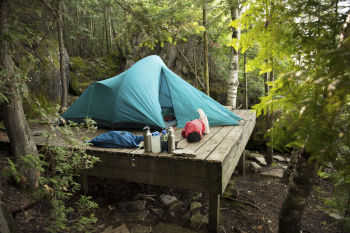
When primitive camping in the White Mountains National Forest, as well as the state parks and lands of New Hampshire, there are a number of rules and regulations that campers must abide by to ensure that the various fragile ecosystems can continue to thrive. In this article I'll cover what regulations need to be followed to minimalize this impact as well as cover the primitive tentsites that are available throughout the region.
With more and more people heading out into the wilderness, the human footprint is causing harm to wildlife, plantlife, and at times can be very problematic to the beauty of the regions we love to escape to.
First, I will mention a few important rules that cover the WMNF.
Important - Camping and Fires are prohibited in the following:
|
|
|
|
|
|
While this is a detailed list provided by the USDA Forest Service, it may not cover other facilities and locations that are possibly not managed by the WMNF. Before beginning your trek be sure to understand what state, federal, or private entity manages and operates the location you plan to visit and call them directly for current operations status.
Now that we've went over some of the basic rules of the backcountry, let's focus on the primitive tentsites.
There are a number of operators of these backcountry sites and I have stayed at a number of them. Some of the nicest and well kept tentsites are managed by the Appalachian Mountain Club. Typically at these tentsites you'll find shared wooden platforms to place tents, a caretaker in season that will collect a fee for your stay ($15 for most at the moment), a composting privy, metal bear boxes, and a general eating area.
Here is an example of what you may find at a tentsite, I'll focus on the popular Liberty Springs Tentsite. At the time of this writting (1/18/2022), Liberty Springs has no lean-to, 7 shared small platforms (2 tents each), 3 shared large platforms (3-5 tents each), composting privy, dishwashing area, and metal bear boxes. You can find this info and info on many of the other AMC managed tentsites here. For many of the other tentsites in the WMNF check the USDA Forest Service website here.
Also note that many of the areas where a backcountry trekker would be leaving their car may require a "Recreation Pass". The annual pass is $30 for an individual and $40 for a household. Daily passes are also available. More info here.
I also recommend purchasing the New Hampshire Hike Safe card. This is a rugged region and when spending a number of days in the backcountry, unforseen accidents can happen. The Hike Safe card is a way to not only support first responders of the region but to take an extra step of precaution in the face of possible rescue liabilities. I have purchased the Hike Safe card for the past 6 years at the time of this writting.
If you ever have any questions call the ranger districts or the AMC directly and they will be very helpful. I have spoken to both entities many times and they have always been very helpful individuals.
Here are some useful resources:
List of WMNF ranger's offices and phone numbers
Appalachian Mountain Club Contact Page
HAPPY CAMPING!
